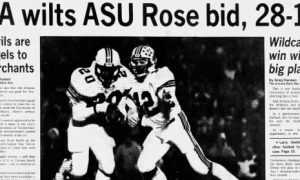
A true read on Rich Rodriguez’s APR value will be after next school year
Arizona coaches Rich Rodriguez and Sean Miller can each take pride in the Wildcats’ Academic Progress Rate (APR) to the tune of $25,000.
That is the bonus each will receive because Arizona’s multi-year APR (in 2009-10, 2010-11, 2011-12 and 2012-13), that was released today by the NCAA, was above their respective thresholds as outlined in their contract. The scores were also well above the NCAA minimum of 930, avoiding potential infractions that include loss of practice time and postseason berths.
The football team’s multi-year APR was 960, above the 952 required for the bonus that was part of the contract Rodriguez signed in February 2013.
Rodriguez is responsible for the 2012-13 school year — his first at Arizona — with a one-year score of 978. The APR scores for this school year (2013-14) will be released next May.
This is how the APR score is determined, according to the NCAA: Each student-athlete receiving athletically related financial aid earns one retention point for staying in school and one eligibility point for being academically eligible each semester. A team’s total points are divided by points possible and then multiplied by one thousand to equal the team’s APR score.
Rodriguez’s marks while at Michigan in 2008-09, 2009-10 and 2010-11 are worth a look.
The Wolverines’ multi-year APR when Rodriguez took over following the 2007-08 school year was 947. With a majority of Lloyd Carr’s players in his first two years of 2008-09 and 2009-10, Michigan’s APR dropped to 936 and 928, respectively.
In the third year in which his recruits started to overtake the Michigan roster, the Wolverines’ multi-year APR increased to 943 in 2010-11. After his firing, a majority of Rodriguez’s recruits remained on Michigan’s roster in the 2011-12 and 2012-13 school years. Michigan’s multi-year APR in those years improved to 951 and 975, respectively.
For the first time, a majority of Brady Hoke’s recruits were on Michigan’s roster in the season completed five months ago, Hoke’s third in Ann Arbor. We won’t know the APR score of the team until next May.

Sean Miller has raised Arizona’s multi-year APR 40 points to 984 in his four years as head coach
The same case will be for Arizona this fall in Rodriguez’s third year. A true reflection of Rodriguez’s APR value will be in the May 2016 report that will detail the 2012-13, 2013-14 and 2014-15 school years under his watch.
The Arizona men’s basketball team’s multi-year APR was 984, much higher than the 949 required for Miller to earn his $25,000 bonus. The single-season mark in 2012-13 was 980.
The 984 multi-year score covers Miller’s first four years as coach of Arizona program. When he took over the program following the 2008-09 school year, the multi-year APR score was only 944. Two of those years were transition years, however, with interim staffs after Lute Olson’s leave of absence in 2007-08 and retirement before the 2008-09 season.
All of the conference institutions in men’s basketball and football were above the NCAA minimum of 930.
Arizona’s multi-year (2010-13) score of 960 in football ranks fifth in the Pac-12 behind Stanford (984), UCLA (979), Utah (970) and Washington (967).
The Wildcats’ season-opening opponent — UNLV on Aug. 30 — is ineligible for a postseason bowl because of its 925 score.
Arizona’s multi-year score of 984 in men’s basketball is tied with Washington for fourth behind Stanford (1,000), ASU (989) and Colorado (985).
All of Arizona’s athletic programs finished above the multi-year NCAA minimum of 930. Those that earned a perfect 1,000 score in the 2012-13 school year were men’s cross country, men’s golf, men’s swimming, men’s indoor and outdoor track, women’s cross country, women’s gymnastics and women’s soccer.
ALLSPORTSTUCSON.com publisher, writer and editor Javier Morales is a former Arizona Press Club award winner. He also writes articles for Bleacher Report and Lindy’s College Sports.
[rps-paypal]
|
|


























